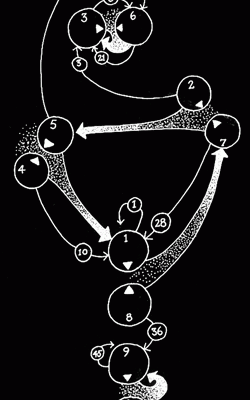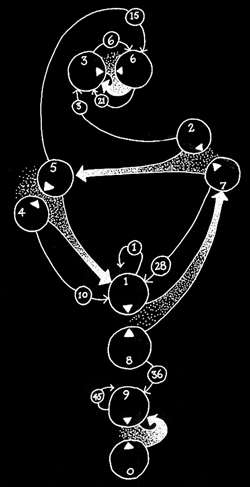
The zine has always had an air of conspiracy theory about it: it’s not difficult to imagine the disarticulated contents of zines– obsessive, selective, forensic snapshots of cultural second-gunmen — redistributed as the autodidact’s bedroom diagram, found typically either in the apartments of detectives or of serial killers. To that effect, the zine can be understood as intimating or evoking a plot. Strategist, designer, and writer Benedict Singleton describes the plot as a mode of creativity, a formulation of design; the plot can refer to an architectural site, as in the ground-plot of a building, as well as a workshop drawing or analytic chart; it also indexes a sequence of fictional events strung into a narrative, and, simultaneously, the subversive scheme of an unseen director, orchestrating events from somewhere in the shadowy wings of the world, from whence the plot twist arrives[i]
Importantly, Singleton identifies the predator-prey symbiosis of the plot, in which the mind of the detective must assume the shape of the mind of the criminal in order to anticipate their next move. The plot is viral, contagious, improvisational, unstable.
Starting in 1997, Abstract Culture was the short-lived and print journal (each issue repetitively titled SWARM) published by the Cybernetic Culture Research Unit. The CCRU, founded by theorists and writers Sadie Plant and Nick Land (and encompassing the early work of Mark Fisher, Kodwo Eshun, Steve Goodman, Ian Hamilton Grant, and Robin Mackay, among others) at Warwick University, through its website, events, and publication of AC, operated as a synthesizer for nascent internet culture, digital art, the philosophy of Deleuze and Guattari, Crowley-style numerology, complexity theory, music journalism and science fiction. However, the manipulative power of electronic music was the key engine behind AC. The new topologies and possibilities for individual and collective bodily movement that jungle projected, the form of musical innovation, could be collapsed into and weaponized as cultural content.
Abstract Culture was not responding to an already existing subculture, whether rave or otherwise, but actively diagnosing, theorising and scrambling existing micro-cultures into a new, as yet unidentifiable synthesis. It can be seen as both a response to, and an extension of, the sonic and visual aesthetics, genres, and practices it was interrogating and theorising.
Both in its design and content, Abstract Culture was an asymptote and engine of the plot-viruses ushered in by mid-90’s technoculture. But rather than attempt to decode a new grand narrative, a new classical plot for whatever web-augmented/web-demented cognition began to do and continues to do to our minds, Abstract Culture took that very condition as symptomatic of an irreversible reckoning with culture as swarms of nested plots all the way down; it wanted to seduce and trap your mind with the rush of re-libidinized philosophy and media theory; to make you complicit. Editions of Abstract Culture felt like instructions to an abstract game, albeit one that was playing you as much as you were playing it.
The theoretical legacy and consequences of the CCRU, in particular the bizarre boomerang of Land’s thought (arcing from his early days as the de-facto head of CCRU, lecturer in philosophy at Warwick, and author of Thirst For Annihilation, a séance on Bataille, to his current, troubling incarnation as a hawkish, neo-neo consevative Neitzchean journalist in Shanghai, and the renewed interest in the first wave of his experiments, thanks to the recent publication of Fanged Noumena, a collection of essays written during CCRU’s inception that continues to stimulate and vex younger theorists born under his sigil), has been more rigorously covered by others. What we’re interested in is Abstract Culture as a singular project of cunning design; as a contemporary plot engine; and as the germ of a language contagion that continues to mutate.
Each issue of Abstract Culture was comprised of essays and interviews of varying fictionality, all of which coalesced around the imaginative affordances of a moment in which our minds seemed to be simultaneously dematerializing and becoming exponentially more intense through various occurrences: jungle, hip-hop, Gilles Deleuze and Felix Guattari, Erik Davis’ ambivalent/trickster techo-shamanism, neuroscience, astrobiology all argued as heralding the prescience of Marshall McLuhan’s black mass for the I as we’ve known it. These texts aimed for not just media theory, but media manipulation. Perhaps it was possible not just to reflect on popular culture, but infect and distort it, anticipate and engineer its near future. Were these sabotage plots possibly overambitious? Naturally. And yet, the efficacy of their aims may only be unfolding via time release, gradually gaining momentum from the late 90’s through the late naughts, judging by their influence on a growing number of young writers and artists.

The texts in AC were accompanied by illustrations: twisted numerology diagrams, geotraumatic topoi, speculative biology (namely, the now-infamous CCRU “spine,” whose uprightness Land considered a major catastrophe in human evolution.) The illustrations in AC (and their oblique relation to the texts) served to dilate the diagonal between interpretation and initiation, between hermeneutics and hermetics; they scanned as hieroglyphs for ancient-future game played in the dusk of our cognitive and physical limits. These graphics were as much characters in the hyperstitious plot of AC as they were symbols or ciphers; you could say that, in another twist, they collapsed the differentiation between the two. The new forms of life that swarmed in the margins most often took the shape of the spiral, which Ray Brassier locates in the work of J.G. Ballard as a temporal figure. During the “When Site Lost the Plot” conference held at Goldsmiths College in 2013, Mackay (a former CCRU associate) suggested that the deep time evoked by Robert Smithson’s Spiral Jetty would find its update in a Spinal Jetty — a biomorphic new monument, a yantra whose geometry activates the inorganic memory coded in our cells. Unlike most zines, AC did not make use of photography or newspaper/magazine images, but seemed to create, or anticipate a following rather than actually cater to one. It was a fandom in advance, a wishful designing of cultural trapdoors.
One of the challenges posed by the web is how writing can account for and participate in its own sense of immersion as a process. Here is where AC’s game of plots (of pursuing the alien exteriorities posed by extreme pasts and futures) remains living and unstable: the deepest immersion is always a disorientation of the mind, a change in the rules; and what faster way to that than a game whose rules only call you further afield?
What, exactly, was the plot/game of AC? The minimal requirements seemed to be a willingness to submit to what Kodwo Eshun referred to as “thinking as psychedelia.” In that sense, the game of AC echoed one of the atavistic games of post-industrial culture, a properly Ballardian one made possible by the automobile: chicken, in which two cars drive head-on towards one another to see who will swerve first before the crash. Only in this version, you are only playing against yourself (and/or whatever is playing you), and you are the plot twist: how fast and how far are you willing to go in your thought experiments? The theoretical-fictional articles in AC threw gauntlets down at your mind: How will you speak if you know that to vocalize is to be possessed? How well can your body adjust to rhythms and frequencies that warp, antagonize, and caress it? How can we meaningfully intervene in the world (politically or otherwise) and its functions if our perception and agency have been shaped by geological processes indifferent to human scale and manipulated upstream by artificial intelligences we’ve secreted but cannot yet communicate with?
Once the design of AC trapped you, or, more accurately, once you had willingly submitted yourself to the trap, you became implicated in the plot of disenchantment: a committed paranoia or materialist Gnosticism towards the present; this zine as a speculative training ground for the demands of the new. One becomes a protagonist trying to understand the terminally serialized story through what Italian philosopher and cognitive scientist Lorenzo Magnani calls “manipulative abduction”, deduction by an alien logic that hollows you out, and, through doing so, engineers your complicity in its unfolding.
You can read Alex Williams and Nick Srnicek’s recent call for an accelerationist aesthetics in the “Manifesto for Accelerationist Politics,” self- published in 2013, as a desire to revivify and modify the experiment of AC, to develop plots, fictions and sensory experiences in which you ascend scales of complexity, intelligibility, and abstraction. AC served as gnomic host for a language virus (Burroughs was another key influence on the zine) that rendered the readers players aware that their circumstances are fragile, local islands in a vast ocean of plots, drawn into their estranging logic.
The plotholes evoked by AC perhaps remain inspirational because they suggest latencies to be reactivated, whose resources could be pirated to create a new, true-to-our-moment science fiction, one in which the lemmas of modern knowledge lead out of the apparent cycling of everyday contemporary life into a realm of thought and action that seems to exist in a parallel (but felt) alternate dimension. To keep winning the game (a relatively new plot twist: there is no “win” the game) – or at least survive – we will have to follow the signs in all their partial intelligibility; to make a pact with the rules and patterns of the abstract (and the rushes of erotic fear that accompany it) that unbind us from common sense and what we think we are.